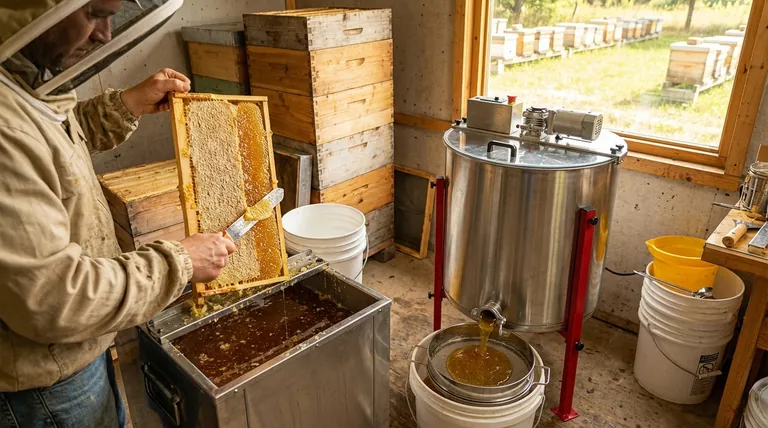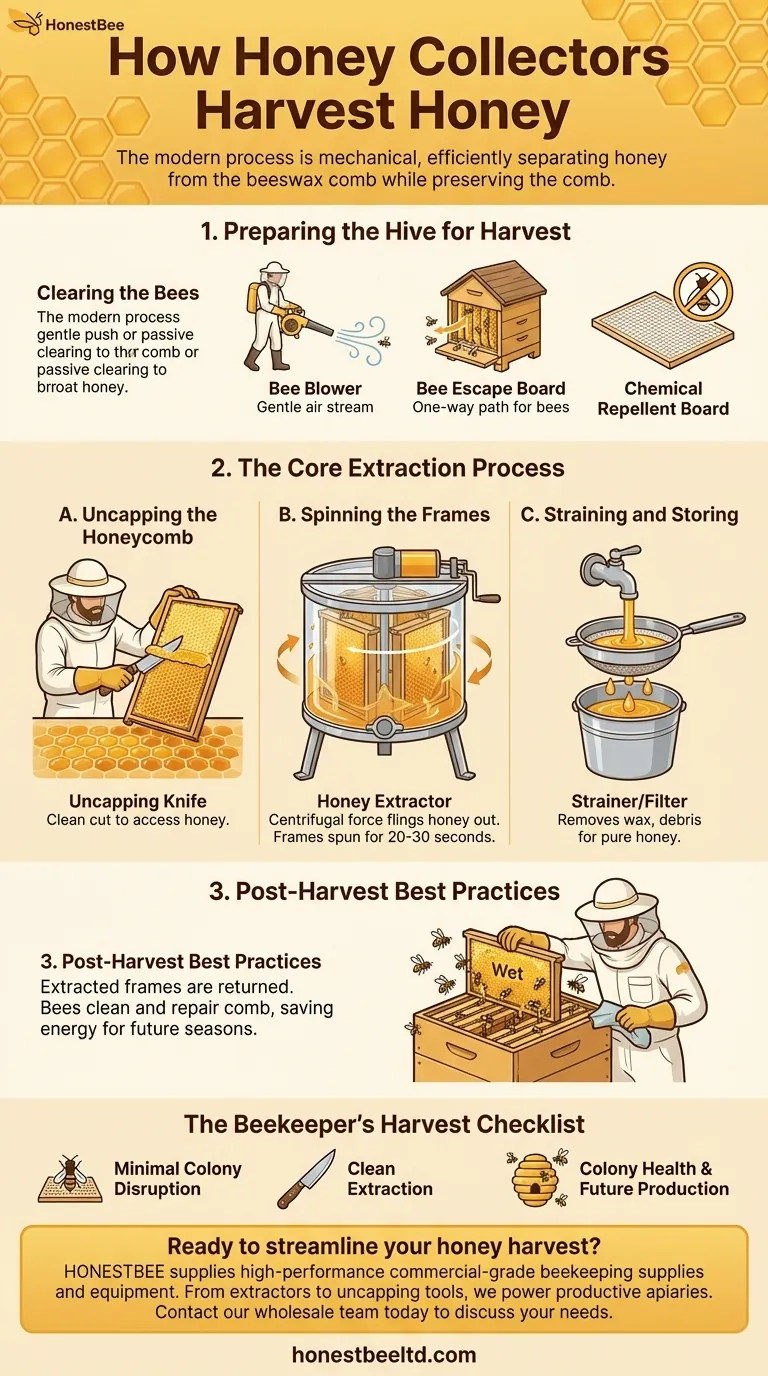In short, honey collectors harvest honey by removing honeycomb frames from the hive, scraping the protective wax caps off the comb, and then spinning the frames in a centrifuge called an extractor. This spinning motion uses force to sling the pure honey out of the comb's cells, where it can then be collected, strained, and bottled.
The modern honey harvesting process is a mechanical one, designed to efficiently separate honey from the beeswax comb while keeping the comb itself intact for the bees to reuse.

Preparing the Hive for Harvest
Before any honey can be extracted, beekeepers must first remove the bees from the honey-filled boxes, known as "supers." This must be done carefully to minimize stress on the colony.
Clearing the Bees
There are several common methods for encouraging bees to leave the honey supers. Beekeepers may use bee blowers, which are essentially leaf blowers that gently push the bees out.
Alternatively, a honey bee escape board can be placed between the honey supers and the main hive body. This one-way door allows bees to move down into the hive but prevents them from coming back up, clearing the supers over a day or two.
Chemical repellent boards are also an option, using a non-toxic substance that bees dislike to drive them out of the supers just before collection.
The Core Extraction Process
Once the frames are free of bees, they are taken to a dedicated space for extraction. This process is typically broken into three key stages: uncapping, spinning, and straining.
Uncapping the Honeycomb
Bees seal each cell of finished honey with a fresh layer of beeswax, known as a "cap." This cap must be removed to access the honey.
Beekeepers use a special uncapping knife or a simple long-bladed bread knife to carefully slice off this top layer of wax. The goal is a clean cut that opens the cells without damaging the underlying comb structure.
Spinning the Frames
With the cells open, the frames are placed vertically into the wire baskets of a honey extractor. An extractor is a centrifuge that spins the frames at high speed.
The beekeeper cranks the handle, and the resulting centrifugal force flings the honey out of the cells and onto the inner wall of the extractor drum. It then drips down to the bottom. After spinning for 20-30 seconds, the frames are turned around to extract honey from the other side.
Straining and Storing
The raw honey, now pooled at the bottom of the extractor, is drained through a spigot. To ensure purity, it is passed through a strainer or series of filters.
This step is crucial for removing any remaining bits of beeswax, bee parts, or other debris. Once strained, the honey is ready to be stored in buckets or bottled directly.
Post-Harvest Best Practices
A successful harvest doesn't end when the honey is in the bucket. The final steps are critical for the health of the colony and the quality of the comb for future seasons.
Returning "Wet" Frames
The extracted honeycomb frames, now empty but still sticky with residual honey, are referred to as "wet." These frames are returned to the original hive.
The bees will immediately get to work, cleaning every last drop of honey and repairing any damaged comb. This recycling of the comb saves the bees an enormous amount of energy, as they do not have to build it from scratch for the next honey flow.
The Beekeeper's Harvest Checklist
The right approach ensures an efficient harvest that is safe for both the beekeeper and the bees.
- If your primary focus is minimal colony disruption: Use a bee escape board a day or two before harvest to clear the supers gently and passively.
- If your primary focus is a clean extraction: Ensure you use a sharp uncapping knife for clean cuts and immediately strain the honey after it leaves the extractor.
- If your primary focus is colony health and future production: Always return the wet frames to the hive so the bees can clean them and reuse the valuable comb.
Ultimately, the entire process is a partnership between the beekeeper's technique and the bees' natural productivity.
Summary Table:
| Step | Key Tool | Purpose |
|---|---|---|
| Clearing Bees | Bee Blower / Escape Board | Gently removes bees from honey-filled frames. |
| Uncapping Comb | Uncapping Knife | Slices wax caps off honeycomb cells to access honey. |
| Extracting Honey | Honey Extractor | Spins frames to fling honey out via centrifugal force. |
| Filtering | Strainer / Filter | Removes wax and debris for pure, clean honey. |
Ready to streamline your honey harvest?
As a commercial beekeeper or equipment distributor, your operation's efficiency is paramount. HONESTBEE supplies the durable, high-performance beekeeping supplies and equipment—from commercial-grade honey extractors to uncapping tools—that power productive apiaries.
Let us help you equip your business for a smoother, more profitable season. Contact our wholesale team today to discuss your needs.
Visual Guide

Related Products
- Electric 8 Frame Honey Spinner Extractor Equipment for Beekeeping
- HONESTBEE 72 Frame Industrial Electric Honey Extractor for Beekeeping
- HONESTBEE 3-Frame Manual Acrylic Honey Extractor
- 2 Frame Stainless Steel Manual Honey Spinner Extractor for Beekeeping
- 8-Frame Electric Self-Reversing Honey Extractor Spinner for Commercial Honey Extraction Equipment
People Also Ask
- What is an extractor in beekeeping? Unlock Sustainable Honey Harvesting
- What equipment is needed for extracting honey? A Complete Guide for Every Beekeeper
- What are the best storage conditions for a honey extractor? Protect Your Investment for Next Season
- Why is cleaning a honey extractor important in beekeeping? Protect Your Honey Quality & Equipment
- What are the differences between manual and electric honey extractors? A Beekeeper's Guide to Power, Speed & Cost



















